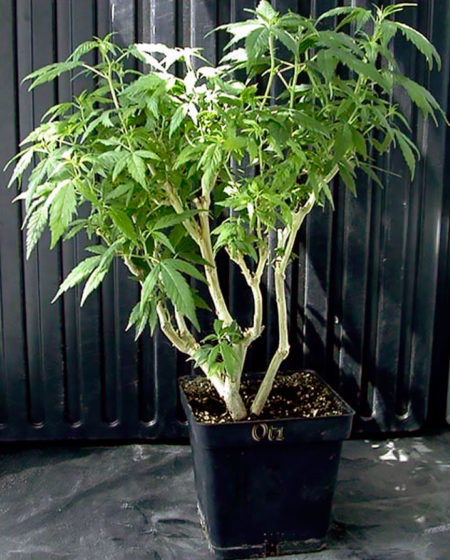In recent years, the popularity of the classic “How to Keep a Bonsai Mum” article, penned by the legendary Oldtimer1 in 2000, has resurfaced. This condensed tutorial offers an ideal bonsai training method for hobbyist cannabis growers with limited space. Now more than ever, this technique is a valuable tool for the many people who are growing cannabis plants in their own homes.
This tutorial is based off the original article, which explains exactly how to keep a bonsai mum. It provides clear instructions on how to train and shape the bonsai mum for a more efficient use of space. As a result, growers can easily cultivate a larger number of cannabis without taking up too much space.
The tutorial also offers tips on how to monitor the cannabis plants to ensure that they are receiving the right amount of light and water. Additionally, it provides advice on how to fertilize the bonsai mum plants to help them thrive. The tutorial also includes an overview of the various tools and materials needed to care for the plants.
Overall, this condensed tutorial is a great resource for both experienced and novice cannabis growers. It provides a step-by-step guide on how to properly train and maintain a bonsai mum plant in a limited space, making it a great tool for home growers. Moreover, it offers valuable tips on how to monitor and fertilize the plants for optimal growth. With the help of this tutorial, growers can now confidently cultivate a larger number of cannabis plants from the comfort of their own home.
READ: The Best Aero Cloner Cannabis Cloning Technique
Are you looking for a fun way to preserve your marijuana genetics? Look no further than our 8-month-old marijuana bonsai mother plants! With a bright lightbulb shining 14+ hours a day near a sunny window, you can keep your plants in the vegetative stage and enjoy free clones forever! Our tutorial will show you exactly how to do it. It’s easy, fun, and a great way to hold onto your favorite genetics! Plus, you’ll get to enjoy free clones for many years to come. With just a few simple steps, you can have your own marijuana bonsai mother plants and start cloning your favorite genetics today!
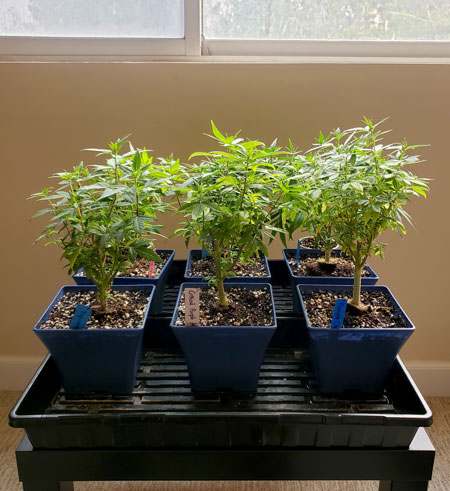
This tutorial will teach you how to turn a cannabis plant into a bonsai mother (giving you access to unlimited free clones!)
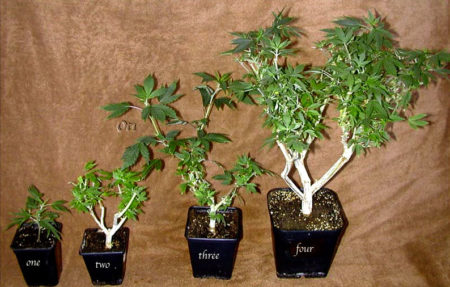
What is a mother plant?A mother plant is a plant kept alive so that clones can be taken from it whenever needed. Clones are the “children” of the mother plant; hence, the term “mother”. There are three ways to clone cannabis plants – in a cup of water (easiest but slow), with seedling plugs (almost as easy but faster), or in an aerocloner (fastest). Keeping mothers is beneficial to growers in two ways – to save money by producing new plants for free (or almost free) and to save good genetics. Clones grown from a mother plant will be identical to the mother plant. Additionally, mother plants can be used to build up a collection of plants with desirable genetics, that can be cloned and grown in future grows. Furthermore, clones are an excellent option for growers that may not be able to buy seeds or young plants. Lastly, mother plants are a great way to ensure a crop of plants with desired traits, as the genetics are already proven.
Instead of having to pay for each seed from a seed bank, a mother plant can be used to create almost unlimited new clones of itself. In addition to not costing anything, new clones are more predictable than seeds from random crosses. Seeds carry a mix of traits from both parent plants, some of which may be recessive attributes, while each clone consistently grows just like the mother.
Taking clones can save a ton of money vs buying seeds because each new plant is simply cut off the mother and grown into a full plant
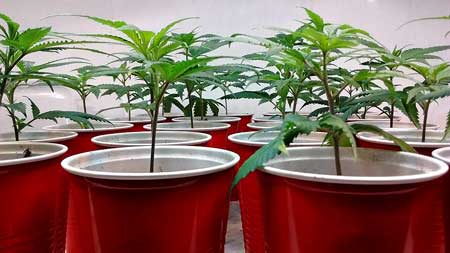
Cloning can be a big money saver over buying individual seeds, but frugality isn’t the only reason to keep mother plants. Sometimes it’s about saving great genetics. Certain cannabis plants are so special they beg to be cloned so more people can enjoy them. If you ever identify a particularly great plant, you can actually take clones of it and turn them into mother plants. You can even take clones in the flowering stage if you just can’t let a certain plant go.
Clones are made by cutting off the ends of branches and planting those pieces so they grow roots. These “cuttings” grow into full plants that are a genetic clone of the mother. When you grow and harvest them, the characteristics will be basically identical to the mother plant.
Why would you want a bonsai mother?
Unlike a commercial grower, most home growers don’t have a lot of grow space to dedicate purely to housing mother plants. Keeping each mother small, like a bonsai tree, lets you maintain a huge selection of genetics in a small grow space without very much electricity.
The bonsai mother technique has become a staple for indoor growers who want to keep a huge variety of genetics in a small cannabis garden. This version of the tutorial cuts out extra discussion and leaves just the instructions with pictures. This way you can get straight to bonsai-ing. But if you ever have a little extra time for some fun and interesting discussion, I highly recommend reading the original article in its entirety by Oldtimer1.
In this tutorial, you’ll learn how to create and maintain many small mother plants in a tiny grow space. Each mother plant can produce hundreds of new clones over time, so you basically gain the power to produce unlimited new plants for free!
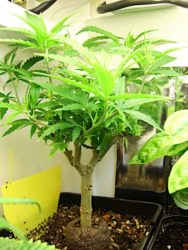
Example of a bonsai plant by Don de Marco
Part 1: How to Create a Bonsai Mother Plant
This tutorial will show you how to create a fully established bonsai mother plant.
This bonsai mother, if well fed, will be able to produce 10 to 30 good cuttings every 14 days under an HID grow light, or every 20 days under fluorescent grow light. This means a 4 ft x 2 ft shop light with 18 mother plants could produce an output of over 9500 cuttings a year.
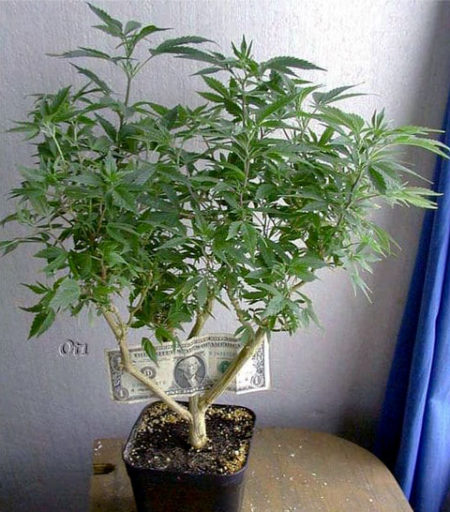
Typical Bonsai Mum
That’s not intensive production, but it allows the connoisseur to keep a good selection of strain varieties in a relatively small space.
1.) Put Chosen Mother in a Square Pot
Lets start by turning a rooted cutting into a mother plant. This is simple. With every batch of clone, there are always a few that stand out because they generally appear sturdier and better looking overall. Pick one or two of these to make your mother plant. Remember this mother plant will provide you with cuttings 4 to 18 times a year for the next 3 to 15 years, so only the best will do.
Note: I find square pots are much easier to deal with when it comes to root pruning, as you will see later.
Pick a fully rooted through cutting and put in a 2.5 inch square pot.
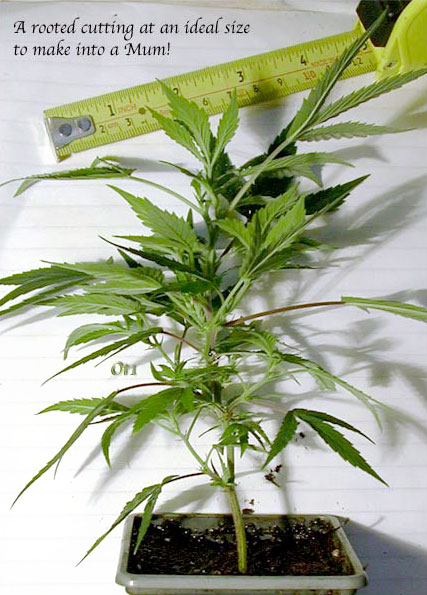
2.) Cut the plant short so it only has 3-4 growing tips left
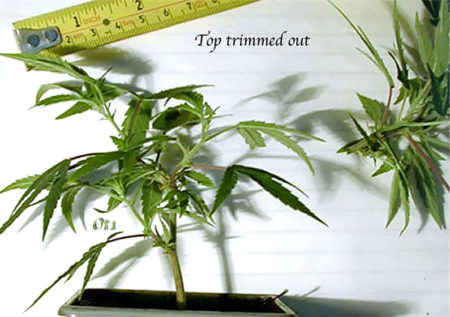
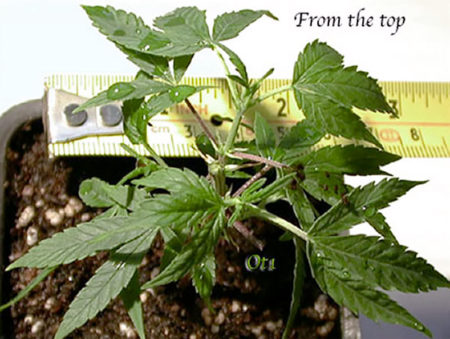
Once you’ve chosen your cutting, trim its top back to leave 3 or 4 side shoots.
Top view
3.) Manipulate the plant into an “open cup” shape (open up the middle as the plant grows)
The little branches you left from before will become the main framework of your mother plant. The goal is to try to get them to form an open cup shape as they grow. The top 2 branches usually grow the fastest unless you take steps to even everything out. The following sequence helps you create a more symmetrical plant.
- “Top” the two tallest branches when they get to about 5 inches long (pinch or snip off the growing tip just above a leaf node).
- Once the remaining branches catch up to the same height as the ones you just topped, then top/pinch the growing tips off them as well.
- This process of topping multiple branches will encourage side shoots to form.
- Remove any branches that grow into the central cup shape.
4.) Take first set of clones
After completing the last step, you should have 6 to 8 leading branches coming up. When they reach 4 to 6 inches long, they can be taken as your first set of clones.
- Cut them back to just above the first leaf node of the new growth
Note: Check out Part 3 of this tutorial (below) for more details and pictures of taking clones
After the cuttings have been taken, the mum is only a tiny bit larger than the last time she was cut back but the main branches will be starting to get thicker.
5.) Move mother plant to bigger pot
After you’ve taken the first set of cuttings, it’s time to move up to the next pot size. A 3 inch sq pot is ideal.
6.) You’ve got a bonsai mother!
You should now have 12 to 16 leading shoots, as well as others coming up from lower nodes. In total there may be 30 potential clones, or more. Any really thin ones or any growing into the center, either cut back to one node or remove altogether instead of taking cuttings.
Here are bonsai mothers at different stages

In the picture:
- The trimmed cutting from above.
- Has had 2 sets of cuttings taken off and is more than ready to move to a 3 inch pot. As you can see it is a little short of Nitrogen, which is why it’s better to transplant to fresh soil after the first set of cuttings.
- This mother plant is in a 3 inch pot. 12 cuttings have been taken with 2 left on to show where to cut back to.
- This is a five year old Mum that has just had 32 cuttings taken off and could do with some more small twiggy bits removed. She is in a 1 liter pot and has been since she was 3 months old.
Note how all have an open center; this allows light to both the center and the outside. It will fill in between taking cuttings but if pruned back to this form, makes better and more even growth giving more good cuttings each time.
General Care and Maintenance
The mother plants need just enough nutrients to keep them healthy. Feed nutrients at half strength twice a month. This keeps them in good general health but doesn’t overfeed them. If you want faster production at any point change to a full-strength feed once or twice. Every 2 to 4 weeks a new batch of cuttings are taken even if they are not needed and just put in the worm bin. You can think of it as being like having to mow the lawn and keeps the mum the same size and form for years. Because so much is taken away they can get short of macronutrients so every month or so give them a foliar spray or light dose of nutrients. Judge this by how the plants are looking not by a timetable.
One of the main things that all growers need to learn is regular close observation. To know when they are healthy and notice the first signs of deficiencies appearing.
Part 2: Root Pruning (Renovation and Maintenance)
Bonsai mother plants will need root pruning once or twice a year to stay healthy. The frequency depends on how intensively they are fed and how good your water quality is.
Note: The root pruning method stays the same whether it’s being used for routine maintenance or renovation of a sick plant.
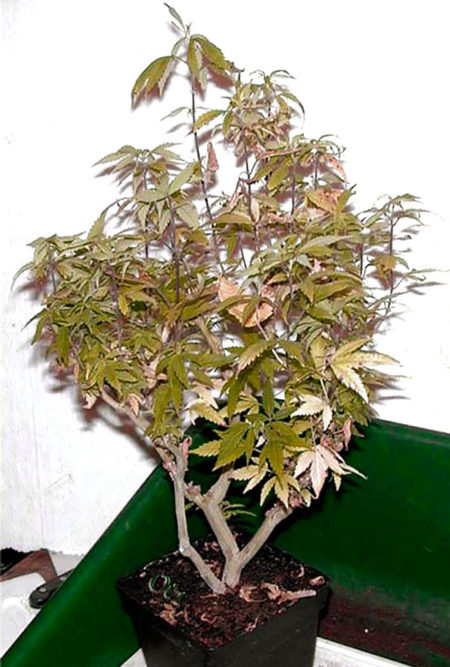
Here we are dealing with a 7 year-old mother plant that hasn’t been root trimmed for nearly a year and was deliberately neglected for the last 10 weeks so you could see the recovery.
First, trim back nearly all the top growth back to the main framework of branches. Leave one or two tiny shoots at the tip of each branch to draw sap and keep the branch alive.
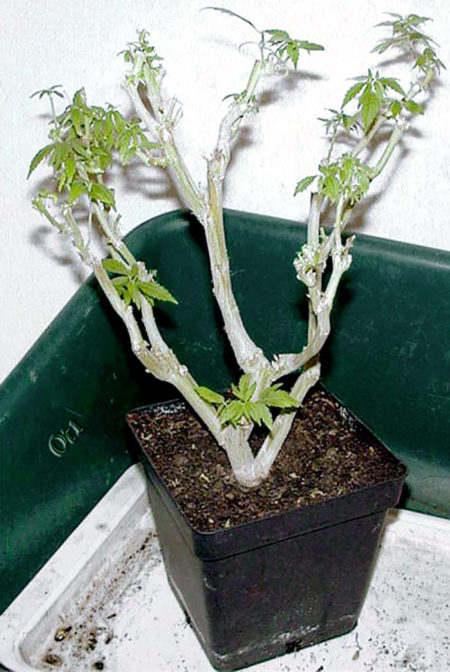
Don’t remove all the shoots and buds because this often causes “die back”. Once that starts the whole plant usually dies within a month or two. But you’re good as long as you leave a few small shoots, even if they’re yellow from lacking N. They will soon start to grow and green up as the new roots start forming!
Next the rootball should have 3/4 of an inch cut off each side and an inch off the bottom.
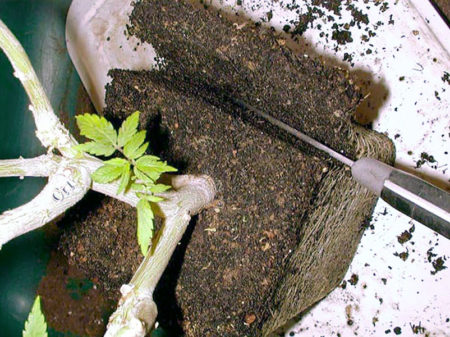
This reduces the 4.5 x 4.5 x 4.5 inch rootball to 3 x 3 x 3.5 inches high after the loose soil is scraped from the top.
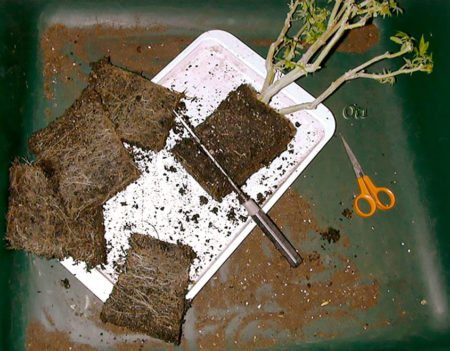
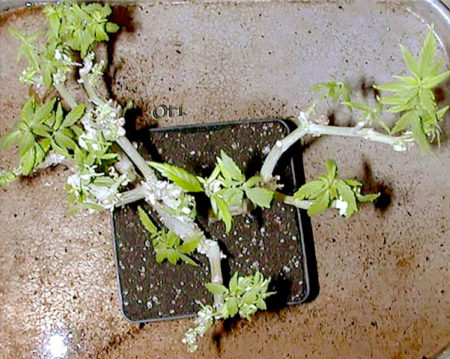
This means that two-thirds of the soil is being replaced. A good full strength organic compost is used when repotting and it only takes a day or two for the roots to really start growing into the new compost. It is very important to make sure there are no voids or air gaps left when packing the sides, use a pencil or small dibber, fill slowly and firm lightly.
Set the bottom of the rootball on about 3/4 of an inch of compost then pack out the sides and finally cover the top with a 1/4 to 3/8 of an inch. This means the mother is planted 1/4 inch deeper every time root pruning is done about 1/2 an inch a year. In a couple of years from now I will cut down vertically and split the plant in two as the side branch will have a root system of its own. Using this method the roots are constantly being replaced and as well the main trunk replaced slowly. This seems to keep the bonsai mother plants healthy for many years.
The last picture is 12 days under an HPS light after the root and top pruning. It tells its own story! Already there are enough nice leaders to make 10 good cuttings.
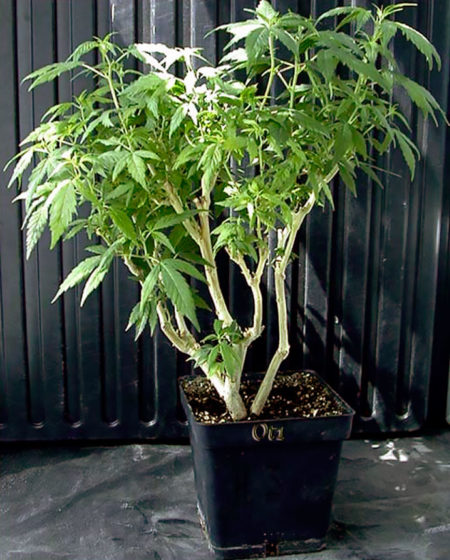
The second mother of our selected “ES” line lasted for just over 15 years using this method. I have also kept prized males for breeding (bonsai father plants) in this pot size and some are over 5 years old.
That’s it. You should have all the info you need to make and root cuttings in compost the make and maintain bonsai mother plants. It’s easy, give it a go!
Part 3: How to Take Clones from Bonsai Mother Plants
This section covers my cloning system in detail, along with a brief outline about our mother plants. Every grower can get the same results by imitating this easy organic system.

Mother plants are kept so their roots are restricted using standard bonsai methodology and techniques. It is an excellent method for keeping mother plants long term and has proved a very reliable system since we developed this method 24 years ago. The longest I’ve kept a mother like this without having to be replaced is just over 15 years.
On average….
- Replace pure indicas every 3 years
- Replace hybrids every 4 to 5 years
- Replace pure sativas every 6 to 7 years.
Of course it depends on the care they are given, and every strain is different. These days most plants are hybrids and you don’t find much “pure” anything, but this can be a helpful guide. Male plants can be kept in the same way and in fact will stand more abuse than mother plants.
My Clone, Mother and Father box
It’s a double deck with two 4ft x 2 ft lights each with 4 x 40w cool white fluorescent lights.
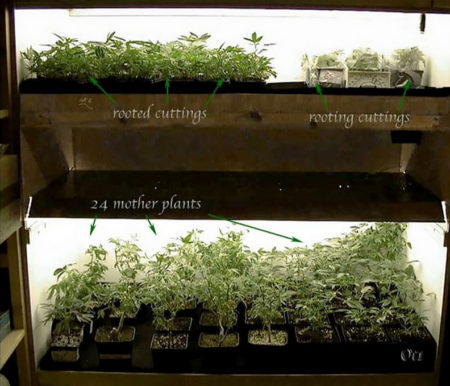
Clone, Mother and Father box
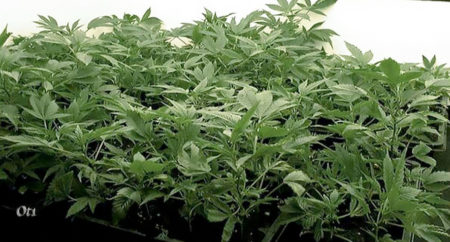
270 rooted cuttings, in plugs ready to go into pots. Close up of top tray right
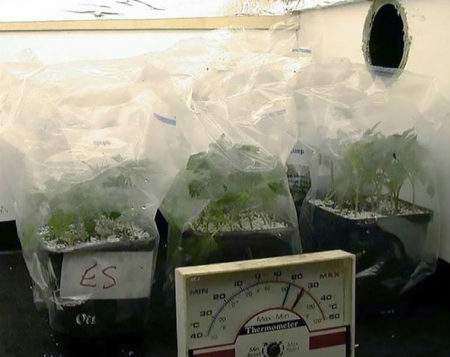
One of the big advantages using bonsai mother plants, is that each only needs a maximum of 8 x 8 inches. So a 2 ft x 2 ft x 2 ft high box with a 4 tube fluorescent shop light can hold 9 mothers. We call the plants we keep Mums and Dads; not to be confused with chrysanthemums
I once read a quote in High Times that said you get genetic degeneration by keeping mother plants long term – this is total rubbish!
Degeneration can certainly occur if a mother plant gets infected with a reversion virus, but the buds produced today from our mother plants is just as potent and good-smelling as when it was first grown out from seed many years ago. In fact, it is better now. We have better lighting and superior growing techniques, allowing the clones to express their potential more fully.
This is our largest mother plant in a 1-liter pot (the largest size used). With all the top growth pictured she is about 13 inches tall and ready to take cuttings. Inset is a cutting being clipped out see below.
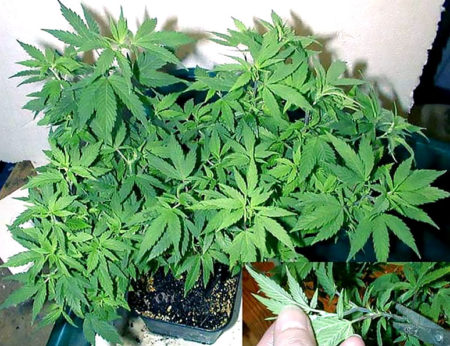
I use fine point scissors for trimming the plants, they are fast and easy to use. Quick enough to do 2 to 3 cuttings a minute. Forget the stories that they bruise the stem and cause rot, it’s rubbish! They do need to be sharp, so buy a new pair and keep them just for this task. As far as hygiene is concerned, providing all your mother plants are free of virus, simply put them through the dishwasher after every session to get rid of the sap build up. This keeps them free and easy to use.
How to prepare the cuttings (refer to picture below)
- This tip is ready to get prepared for rooting
- Snip off the side shoot and leaf the node you want to root.
- Cut just below the node you want to root.
- Dip the trimmed node in rooting hormone.
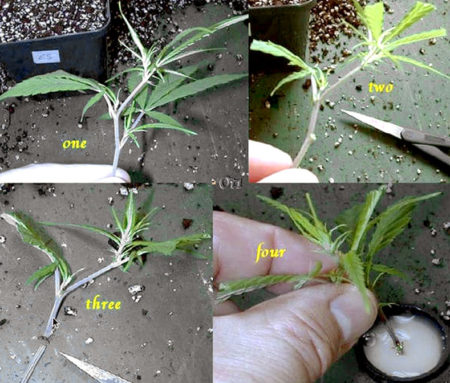
How to Insert the Cuttings
- Use a 3.5 inch square pot to root in
- Fill with half perlite and half universal compost or rich potting soil
- The mix is pre-soaked with water dosed with 1 ml of 35% or 2ml per litre of 17.5% H2O2 and 5 ml of Maxicrop Liquid Seaweed
- Then the cuttings are dibbed in to the compost, 9 to 12 per pot
- The dibbed cuttings are then watered in using a fine rose same mix as above to settle them in.
- Cover with a plastic bag and put under constant 24-hour lighting
- Preferably cool-white fluorescent lighting at 20 w per sq foot and a temperature of 75 degrees fahrenheit.
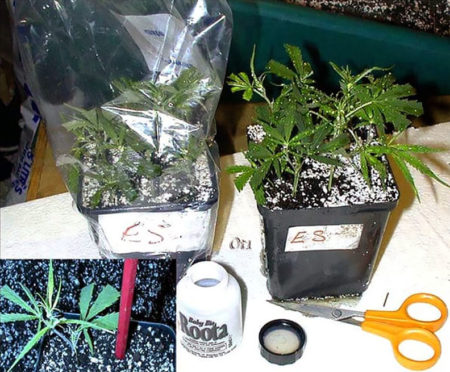
Inserting cuttings and covering with bag
“There are a number of reasons for not rooting directly into plug trays.”
Lets look at what we need from a rooted cutting… We want one that is suited to growing in a confined space i.e. a pot. They are as closely matched as possible. To get good yields from a grow, uniformity is the rule. It is no good having one plant that produces 50 grams when its 2 neighbors only produce 15 grams each. They are identical stock but this is what is often seen in grow after grow. It is much better to try and get all the plants averaging 35 grams well within the capacity of the stock line of a plant that can make 50 grams.
Remember we are talking about growing in soil based or soilless compost mixes. The root type that the cutting produces is very important, lots of fine feeder roots are the ideal, anchor and tap roots are totally unwanted when growing in a pot. Remember the amount feeder root mass directly effects the potential crop weight
The 3.5-inch pots are 4 inches high; the rooting mix is very open with low nutrient content. This encourages early taproot development. Not all the cuttings will have rooted at the same time, so when they are transferred to the plug trays the root balls are trimmed to the same size and the tap root is removed, this goes a long way towards equalizing the clones. Once they are transferred as below they tend to stay pretty even and grow on rapidly. To show what we are looking for some equalized clones grown on and just put into flower. There are several varieties in this grow and there is not more than an inch or so between plants in each variety. They are placed by variety to make a stadium effect and make maximum use of light.
Around ten days later the cuttings will have rooted through. The rootball is gently broken up, each cutting has its roots trimmed back to equalize the cuttings and make them fit the plug tray! Full strength peat or coir compost using organic base fertilizers, are used for this.
Then they are put back in the Clone/Mother box for about 5/6 more days until thoroughly rooted through, this is very important at all stages of repotting! Fully rooted plants just jump ahead when moved on– we have found that plants moved into bigger pots too early typically produce 25% to 30% less final crop weight!
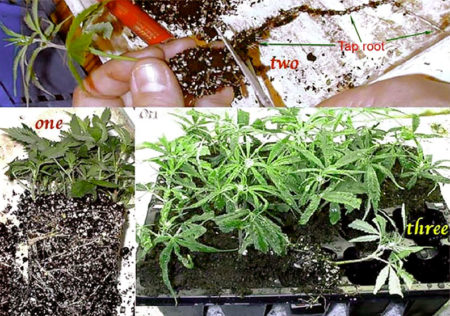
Moving the rooted cuttings to plug trays.

Cuttings in plug trays a few days later ready to move on to their first pots.
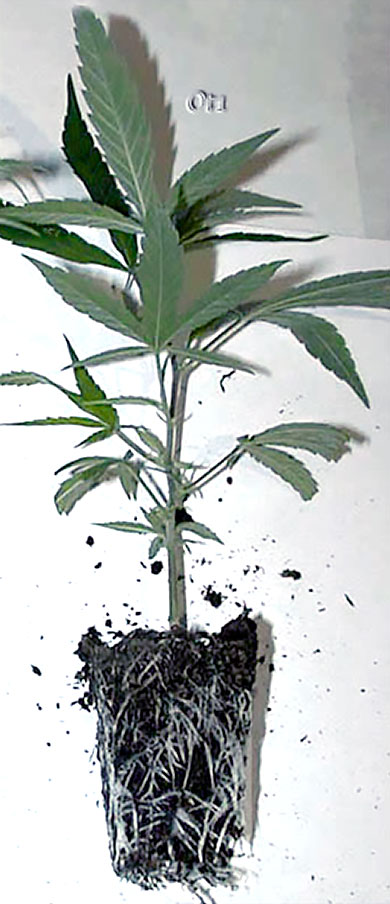
Showing a cutting out of the plug tray, fully rooted out and ready to go.
Cuttings like this can be taken from any plants in the vegetative stage.
That’s it…you are ready to grow!

